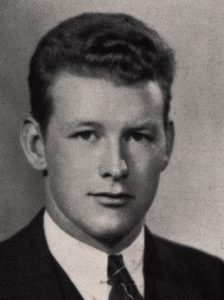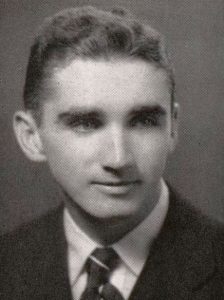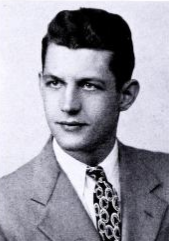The Muhlenberg Memories Project
Military Training
Jack H. Blair III ’38, wrote about how paratroopers are “toughened—they crawl through animal entrails to accustom themselves to the smell and nausea of rotting bodies. They march through treacherous swamps, deserts, jungles over mts. Etc. Wielding knives and bayonets are their specialty.
“Theree have been more than 120,000 parachute jumps at Fort Benning, Ga. And with all these jumps–there have been very few accidents that were fatal due to a malfunction of a ‘chute. Each jumper has strapped to his back; a T-5 pack assembly, including a main pack and a reserve ‘chute. The two parachutes alone have the combined area of 1,196 sq. feet of silk. Well trained parachutes open bail out of a plane at fifteen men every eight or nine seconds— and take it from me– that is really moving up there’!A jumper falls free at approximately 125ft. per second. With the static line’ chute there is a break cord attached to the static line which in turn is attached to the plane. A jumper will fall about 100 to 130 feet before his parachute opens. He may or may not experience the knowledge of falling. A fully equipped paratrooper receives a little shock but he is trained to absorb this shock in a certain manner and also by the art of tumbling” (7 April 1943).

Another paratrooper, 1st Lt. James F. Brown, Jr. ‘41, of the 513th Parachute Infantry, Fort Benning, Georgia, wrote about his training experiences. “I have just recently completed the Parachute School, which, I must say, is very, very rugged. In fact, the physical conditioning phase of it was the toughest thing I have ever come across. I can easily understand now why the paratroopers are the best soldiers in the world.
The jumping part is the big thrill naturally. There is nothing that can compare with it. The few seconds in midair are something I’ll never forget. The funny part is that there is no sensation of falling. You merely seem to sit in the air and watch the plane go by. Then somebody hits you over the head with a mallet, and you know your chute has opened. After that you simply float downward with nothing to worry about except the possibility of a broken leg upon landing. But being on the light side, I usually come in easily and haven’t ever come close to getting hurt. I found that getting bounced around on the wrestling mat was much tougher” (21 May 1943).

In contrast to the rigors of training in the Parachute Infantry, and by no means the typical of most training experiences, Richard Erb ’46, writing on April 14, 1944, alerted the Alumni Secretary to his transfer to a new unit and wrote that it was “not completely organized as yet” so he spent time at the local country club in Sacramento playing 27 holes of golf.


